
An echinoderm is any member of the phylum Echinodermata of marine animals. The adults are recognizable by their radial symmetry, and include starfish, sea urchins, sand dollars, and sea cucumbers, as well as the sea lilies or "stone lilies". Adult echinoderms are found on the sea bed at every ocean depth, from the intertidal zone to the abyssal zone. The phylum contains about 7000 living species, making it the second-largest grouping of deuterostomes, after the chordates. Echinoderms are the largest phylum that has no freshwater or terrestrial members.

Starfish or sea stars are star-shaped echinoderms belonging to the class Asteroidea. Common usage frequently finds these names being also applied to ophiuroids, which are correctly referred to as brittle stars or basket stars. Starfish are also known as Asteroids due to being in the class Asteroidea. About 1,500 species of starfish occur on the seabed in all the world's oceans, from the tropics to frigid polar waters. They are found from the intertidal zone down to abyssal depths, 6,000 m (20,000 ft) below the surface.

The crown-of-thorns starfish, Acanthaster planci, is a large starfish that preys upon hard, or stony, coral polyps (Scleractinia). The crown-of-thorns starfish receives its name from venomous thorn-like spines that cover its upper surface, resembling the biblical crown of thorns. It is one of the largest starfish in the world.
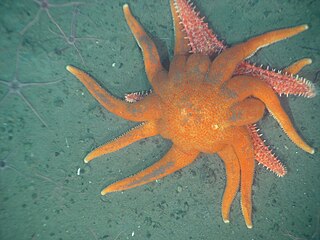
The Valvatida are an order of starfish in the class Asteroidea, which contains 695 species in 172 genera in 17 families.

Linckia laevigata is a species of sea star in the shallow waters of tropical Indo-Pacific.

Asterias amurensis, also known as the Northern Pacific seastar and Japanese common starfish, is a seastar found in shallow seas and estuaries, native to the coasts of northern China, Korea, far eastern Russia, Japan, Alaska, the Aleutian Islands and British Columbia in Canada. Two forms are recognised: the nominate and formarobusta from the Strait of Tartary. It mostly preys on large bivalve molluscs, and it is mostly preyed on by other species of starfish. Population booms in Japan can affect the harvest of mariculture operations and are costly to combat.
Asterina phylactica is a species of sea star. It can be found in geographically widespread sites around the British Isles and in the Mediterranean Sea. It has five arms, is about 1.5 cm across and is of a green colour with central brown markings. The species was formally described in 1979 and is very similar to Asterina gibbosa.

Pisaster ochraceus, generally known as the purple sea star, ochre sea star, or ochre starfish, is a common starfish found among the waters of the Pacific Ocean. Identified as a keystone species, P. ochraceus is considered an important indicator for the health of the intertidal zone.
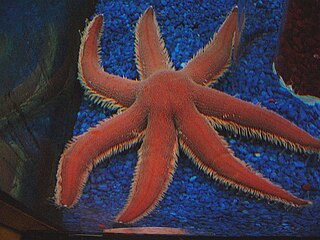
The seven-armed sea star is a species of sea star (starfish) in the family Luidiidae. It is found in the eastern Atlantic Ocean and the Mediterranean Sea.

Leptasterias hexactis is a species of starfish in the family Asteriidae, commonly known as the six-rayed star. It is found in the intertidal zone of the western seaboard of the United States. It is a predator and is unusual among starfish in that it broods its eggs and young.

Solaster dawsoni, the morning sun star, is a species of starfish in the family Solasteridae. It is found on either side of the northern Pacific Ocean. It has two subspecies:

Acanthaster brevispinus, the short-spined crown-of-thorns starfish, is one of the two members of the starfish genus Acanthaster, along with the much better-known A. planci, the common crown-of-thorns starfish.

Asterias forbesi, commonly known as Forbes sea star, is a species of starfish in the family Asteriidae. It is found in shallow waters in the northwest Atlantic Ocean and the Caribbean Sea.

The sand star, Luidia foliolata, is a species of starfish in the family Luidiidae found in the northeastern Pacific Ocean on sandy and muddy seabeds at depths to about 600 m (2,000 ft).
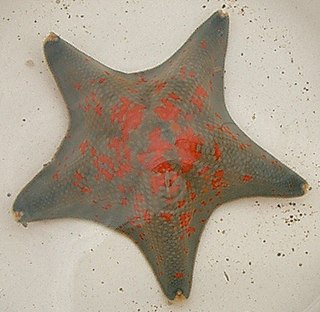
Patiria pectinifera, the blue bat star, is a species of starfish in the family Asterinidae. It is found in the northern Pacific Ocean along the coasts of Japan, China and Russia. It is used as a model organism in developmental biology.

Sea star wasting disease or starfish wasting syndrome is a disease of starfish and several other echinoderms that appears sporadically, causing mass mortality of those affected. There are around 40 different species of sea stars that have been affected by this disease. The disease seems to be associated with raised water temperatures in some places, but not others. It starts with the emergence of lesions, followed by body fragmentation and death. In 2014 it was suggested that the disease is associated with a single-stranded DNA virus now known as the sea star-associated densovirus (SSaDV); however, sea star wasting disease is still not fully understood.
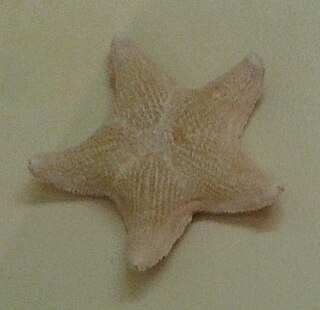
Asterina stellifera is one of thirty species of small bat star in the genus Asterina. It is mainly found on the east coast of South America, ranging from Cabo Frio, Brazil to Mar del Plata, Argentina. In the past decades, their numbers have depleted and are currently abundant only in the southern limit of its former range. Due to this decline, it is on Brazil’s endangered species list. It has a slow growth rate and relatively long lifespan. A. stellifera is an omnivorous generalist predator, and modifies the abundance of other invertebrates and algae in subtidal marine communities.
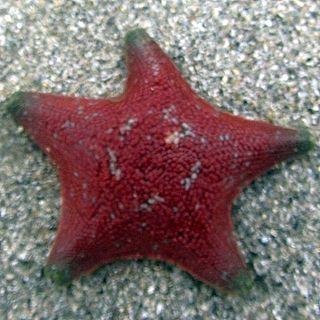
Patiria chilensis is a species of starfish in the family Asterinidae. It is found in the southeastern Pacific Ocean along the coasts of South America. It is a broadly pentagonal, cushion-like starfish with five short arms.
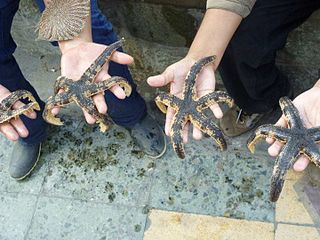
Luidia magellanica is a species of starfish in the family Luidiidae. It is found in the southeastern Pacific Ocean on the coast of South America.

Echinaster is a well-studied and common genus of starfish containing ~30 species and is the second-largest genus found within the family Echinasteridae. The genera Henricia and Echinaster encompass 90% of all the species found within the family Echinasteridae. It contains 30 species, however the number of species in this genus is still debatable because of uncertainty within the genera. This genus is currently sub-divided into two sub-genera: Echinaster and Othilia, evolutionary relationships between the sub-genera is not understood. Echinaster are found in the Pacific, Atlantic and Indian oceans, with most species being studied in the Gulf of Mexico and Brazil. The sub-genera Othilia is thought to encompass species mainly found in the Gulf of Mexico and Brazil. Echinaster is often one of the most studied species within the family Echinasteridae and is often used to find evolutionary relationships.




















